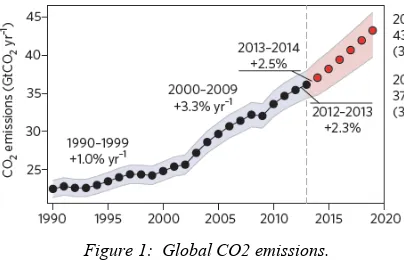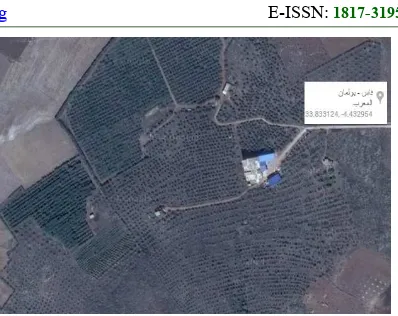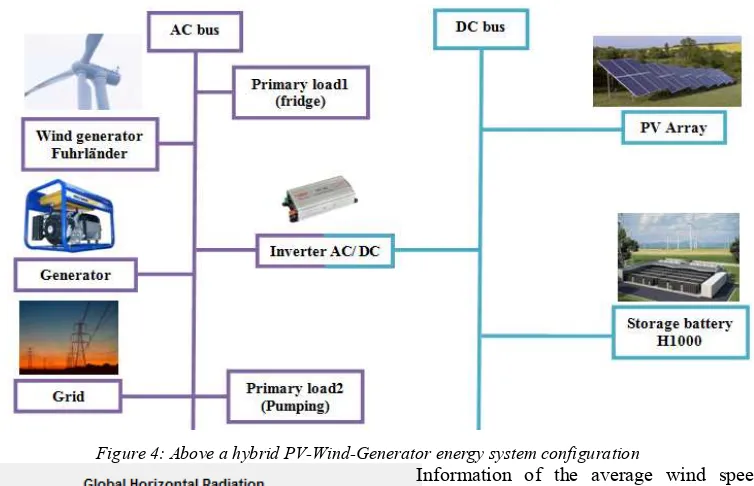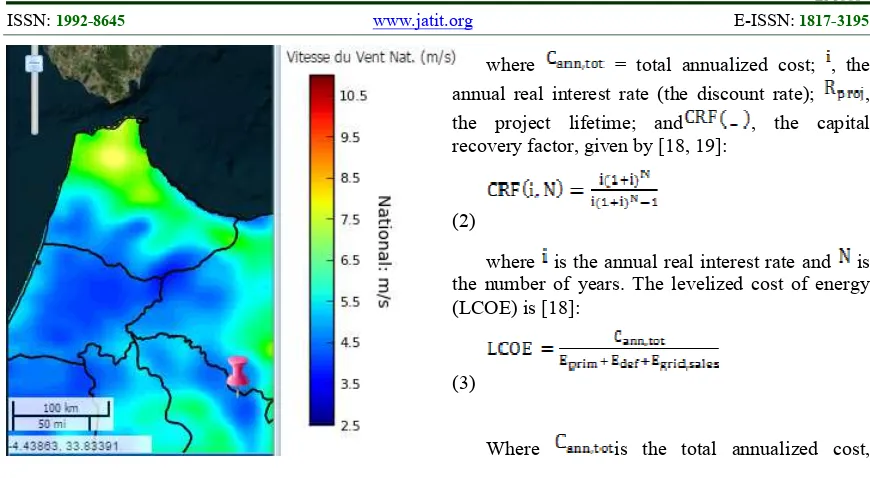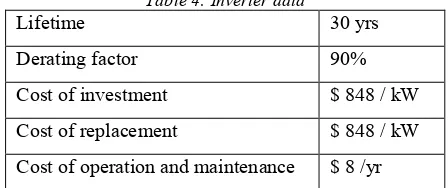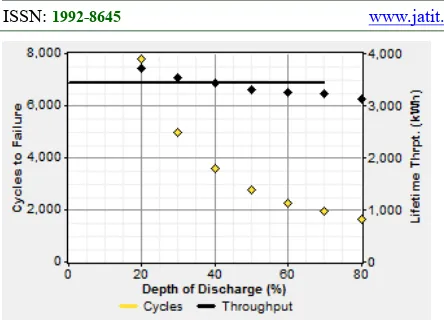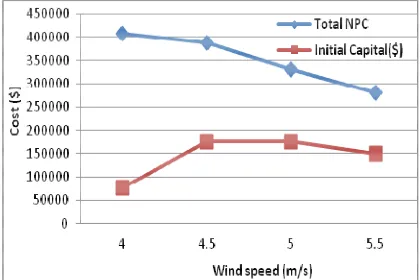ISSN: 1992-8645 www.jatit.org E-ISSN: 1817-3195
OPTIMAL SIZING OF GRID-CONNECTED PV-WIND
SYSTEM
CASE STUDY: AGRICULTURAL FARM IN MOROCCO
1Mohammed BOUSSETTA, 2Rachid ELBACHTIRI, 3Karima ELHAMMOUMI, 4Maha
KHANFARA 1
REEPER Group-EST, LESSI Lab-FSDM, USMBA-Fez, Morocco 2
REEPER Group-EST, USMBA-Fez, Morocco
3,4REEPER Group-EST, PERE Laboratory-FST, USMBA-Fez, Morocco
E-mail: 1mohammed.boussetta@usmba.ac.ma, 2rachid.elbachtiri@usmba.ac.ma, 3
elhammoumi2646@gmail.com, 4maha.khanfara@usmba.ac.ma
ABSTRACT
Faced with the reality of limited fossil fuel reserves and the issue of greenhouse gases, agriculture, like other economic sectors, must develop efficient production systems in energy inputs. Within this context, this paper focuses on the problem is to optimize and size a power generation grid-connected system, resulting from the combination of renewable energy sources (RES), to supply power an agricultural farm of 37 hectares and a cold room for conservation of summer fruit, in the region of Sefrou-Morocco. In this article, economic study of hybrid electricity generation from the site was undertaken, with the aim of minimize the net present cost (NPC) which is the sum of the cost of the initial investment and the net present value of all costs of operation and maintenance over the estimate life of the project, which is 25 years. The environmental analysis was also carried out; emissions and renewable energy generation fraction (RF) are calculated as the main environmental indicator. Simulation results show that the hybrid energy system (HES) comprising one wind turbine of 100 kW, 15 kW of PV arrays and 40kW sized power converters connected to the grid, is the best option to meet the requirement of the load demand considered in this study, thereby producing 323,815kWh/yr, which 81% of electricity comes from RES and the remaining energy is provided by the grid, as well HES reduce about 51,000 Kg of emissions per year. In addition, a sensitivity analysis was performed considering four average values of wind speed
Keywords: Grid-Connected PV-Wind System; Net Present Cost; Homer; Optimal System; Agricultural
Farm
1. INTRODUCTION
Today, energy is a major global issue. Indeed, our company is highly dependent on energy for its development. According to statistics from the International Energy Agency, 81.7% of the energy consumed were fossil [1]. However, these energy sources - gas, oil, coal - doomed to dry up in the coming decades, are now also proved to be air pollution causes. We are at 37 billion tons of CO2 emitted into the atmosphere at the end of 2014 as shown in Figure 1 representing an increase of 2.5% [2]. The objective to contain global warming within 2%, by the year 2100 will be difficult to achieve [3]. Therefore, the development of renewable energy, enhancing research in the field of new energy technologies, and energy efficiency have
become central issues in the strategie planing of nations and the international community.
In Morocco the growth rate of domestic consumption of electricity was 8.4%. With an average annual rate of 7 to 8% since 2003 [4], the rate of progression in demand will inevitably require other means of production, especially in the agricultural sector, which accounts for 13% of national energy consumption [5], this figure is set to increase with the projects undertaken as part of the Green Morocco Plan (increasing mechanization, irrigation, etc.).
ISSN: 1992-8645 www.jatit.org E-ISSN: 1817-3195 residential house) and, in some cases, produce more
[image:2.612.91.293.166.296.2]energy than required for needs, for that reason, it would be envisaged to use storage batteries to store excessive energy for later use in deficit generating conditions.
Figure 1: Global CO2 emissions.
Solar photovoltaic (PV) generating systems and wind generating systems are considered to be good candidates for the design of agricultural systems. Both solar and wind energies are pollution-free and freely available everywhere in the world. However, due to the intermittent nature of solar energy, for example, a standalone solar photovoltaic energy system cannot provide reliable power during non-sunny days [6]. Similarly, a wind energy system does not produce usable energy for a considerable portion of time during the year due to significant fluctuations in the magnitude of wind speed from hour to hour throughout the year [7], Therefore, expensive energy storage systems will be required for each of these systems in order to satisfy the power demands.
Hybrid wind/PV power systems have become used taking the fact that they combine complementary characteristics of wind and solar sources to enhance the system’s reliability and reduce its costs [8-10]. Sizing, optimising and controlling renewable sources in an hybrid energy system (HES) are very essential for its techno-economical feasibility and stability [11,12].
In recent years, many efforts have been made to increase the implementation of renewable sources of energy through research and application. The more practical microgrids combine two or more different sources of energy in the best possible manner to cater to local loads with the ability to operate either connected or disconnected with the utility grid. Luna-Rubio and al. gave an overview on sizing methodologies considering hybrid energy metrics like LPSP, SOC, LCE, etc.[13]. Likewise Hina Fathima and Palanisamy provide an overview of the various hybrid microgrid systems currently being explored and the
various optimization methods and applications that are being employed in ref [14].
On one side, much research has been conducted by various researchers in the field of off-grid systems. Adaramola and al. studied the possibility of using the hybrid HES PV/diesel for power generation in rural and semi-urban areas in Nigeria [15]. A new methodology with the aim to design an autonomous hybrid PV-wind-battery system is proposed in ref [16], case studies of isolated sites located in different regions in the world have also been made by several Scientifics’, for example B. Askari and al. [17] in Iran, Makbul A.M. Ramli in Saudi Arabia [18] and in China by Chong Li [19]. Moreover, Saheb-Koussa who did an economic and technical study of a hybrid system (wind– photovoltaic–diesel) for rural electrification in Algeria [20].
On the other side, some studies have focused on the Hybrid systems connected to the public electricity distribution network , this can be done by customers who are located close to the grid [21]. Various methods have been utilized by different researchers with various optimization algorithms or using software packages in planning and sizing the grid-connected systems. The authors in ref [22] present the control strategies to operate a grid-connected hybrid system, Makbul A.M. Ramli and al. have also achieved , with HOMER simulation , an optimum design for a grid-connected PV system in Makkah, Saudi Arabia [23]. Equally, micropower optimization program Homer was used in economic analysis of standalone and grid connected hybrid energy systems by Belgin Emre Türkay and Ali Yasin Telli. The pilot region in this study is Electrics & Electronics Faculty, Istanbul Technical University [24]. Elieser Tarigan simulates the feasibility of installing a grid-connected photovoltaic (PV) system in a typical residential areas in Surabaya, Indonesia, using PVsyt and RETScreen software [25]. A feasibility and cost benefit prospection of grid connected hybrid power system (wind–photovoltaic) in an Algerian coastal site was made by Djohra Saheb Koussa, and Mustapha Koussa, presents the feasibility and cost benefit analysis of wind and photovoltaic power systems connected to a conventional grid using Matlab simulink and HOMER softwere [26]. However, this study shows that the renewable energy will not be immediately economically viable.
ISSN: 1992-8645 www.jatit.org E-ISSN: 1817-3195 of hybrid systems has been conducted with
mathematical methods and simulation software in different countries. However, few researchers have focused on the study and the technical and economic feasibility of a hybrid system Wind /PV/ diesel / battery for an agricultural application. Similarly few researchers take into account the actual load data, temperature effects, and the influence of wind speed.
The aim of this paper is to examine the feasibility of various hybrid power generation systems covering the electrical needs of an agricultural farm of 37 hectares and a cold room for the conservation of summer fruit, and to find the best alternative of a set of given solutions, which is most cost- effective or has the highest achievable performance under the given constraints.
2. LOCATION OF THE SITE
[image:3.612.320.519.75.233.2] [image:3.612.132.273.461.616.2]The performance of photovoltaic panels and wind turbines are directly correlated with climatic data which are principally of solar radiation and wind speed. For a given load profile, the system size increases when climate resources are low [27]. The information required for this study was collected based on the load profile, average monthly wind speed and solar radiation at the Ribat elkheir in the year of 2014. Ribat Elkheir is a town in Sefrou Province, Fès-Boulemane, Morocco (Figure 2).
Figure 2: .Location of Ribat Elkheir, Sefrou
Figure 3 shows de satellite image of farm and the cold room.
Figure 3: Satellite image of the farm
3. SYSTEM CONFIGURATION
The proposed configuration of the hybrid renewable energy system comprised of PV panels, wind turbines and diesel generator is shown in Figure 4. A storage battery is added into the system as a backup unit and act as a storage system. The HES will always operate connected to the grid. On the other hand, the system requires DC/AC inverters to convert DC power to AC power, which is what is commonly used in the farm. This basic architecture is used to test all configurations in order to determine the optimal solution which is most cost- effective.
4. ELECTRICAL LOAD INFORMATION
For the consumption profile, we use data provided by National Office of Electricity and Drinking Water. They correspond to the electric power consumed for a typical farm.
.
Figure 5: Monthly load of the site
The loads to be supplied are:
• Primary Load 1: Pumping for a farm of 37
[image:3.612.313.568.511.635.2]ISSN: 1992-8645 www.jatit.org E-ISSN: 1817-3195 average energy consumption of 113 kWh
/day.
• Primary Load 2: A fridge for volume
conservation 6125 m3 (can store about 500,000 kg of fruit) and two administrative offices one for the owner and one for the accountant, with an average consumption equal to 379kWh/day.
Figure 5 shows the profile of the monthly load of the site
5. RENEWABLE ENERGY RESOURCES AT
THE FARM
[image:4.612.122.499.234.477.2]The resources data at the site are taken from Ribat Elkheir with the latitude of 33.83 North and longitude of 4.33 West [28]. The time zone for this village is GMT. The monthly averages for solar insolation in Ribat Elkheir as shown in Figure 6 available on the National Aeronautics and Space Administration (NASA) website[29].
Figure 4: Above a hybrid PV-Wind-Generator energy system configuration
Figure 6: Solar radiation curve.
HOMER software converts this data into an hourly values required for the model. Our average daily radiation is 5.24389 KWh/m2. The array slope angle is set to 33.8167° with a derating factor of 80% and ground reflectance is 20%.
Information of the average wind speed for Ribat Elkheir is derived from the “Renewable energies Atlas of Morocco” [30]. This digital Atlas presents in a clear and precise way wind, solar and biomass resources, in order to help the professionals to identify the convenient zones for setting-up future projects of green power production. Figure 7: shows the wind speed at the site of implementation, where the annual average winds speed is ~5m/s.
ISSN: 1992-8645 www.jatit.org E-ISSN: 1817-3195
Figure 7: The average wind speed
6. SYSTEM ECONOMIC DATA
Economic data at the time of this study are the most important parameters influencing on the results of sizing, such as the price of energy sold by the grid, which is ~$ 0.2 / kWh in Morocco and diesel fuel set to be $1 per liter.
Renewable sources tilt toward having high initial capital costs and low operating costs, while conventional non-renewable sources usually tend to have low capital and high operating costs. Therefore, in the optimization process, HOMER operates the system in a way so as to diminish the total NPC.
The NPC include the costs of initial construction, component replacements, maintenance, fuel, cost of buying power from the grid, and miscellaneous costs such as fines ensuing from pollutant emissions. Revenues take into account the income from selling power to the grid, plus any salvage value that occurs at the end of the project lifetime. As for the NPC estimation, costs are seen as positive and revenues are negative. HOMER assumes that all prices escalate at the same rate over the project lifetime.
The annualized costs are then summed for each component, together with any miscellaneous costs, so as to find the total annualized cost of the system. The total net present cost is [14, 19]:
(1)
where = total annualized cost; , the annual real interest rate (the discount rate); , the project lifetime; and , the capital recovery factor, given by [18, 19]:
(2)
where is the annual real interest rate and is the number of years. The levelized cost of energy (LCOE) is [18]:
(3)
Where is the total annualized cost,
and are the total amounts of primary and deferrable load, respectively, that the system serves
per year, and is the amount of energy sold to the grid per year.
6.1 Photovoltaic economic information
[image:5.612.87.522.71.310.2]PV modules that could meet the needs of this project are available in Morocco and cost about $ 1,700 for one kWc [31]. In our proposed system, replacement cost is assumed to be equal to $ 1400/kW and its operating and maintenance costs are $ 28 /yr. The operating costs include salary and Maintenance of a technician and 1% of the investment per year.
Table 1: PV data
Lifetime 30 yrs
Derating factor 90%
Cost of investment $ 1,700 /kWc
Cost of replacement $ 1,400 /kWc
Cost of operation and
maintenance $ 28/yr
6.2 Economic parameters related to wind
generator
ISSN: 1992-8645 www.jatit.org E-ISSN: 1817-3195 which stated a cost of ~1,500 k$/MW for a wind
turbine. Distribution of these investments is: 72% for wind turbines, 8% for studies, 10% for civil engineering, 4% for connection, 3% other construction costs 1% of provisions for dismantling, and 2% financial costs. Operating and maintenance costs are about 47 k$/MW/year.
Table 2: Wind generator data Lifetime 20 yrs
Hub height 35m
Cost of investment $ 1500 / kW
Cost of replacement $ 1500 / kW
Cost of operation and
maintenance $ 5000/yr
6.3 Diesel generator characteristics
A Diesel generator (DG) is characterized by its fuel consumption and efficiency. The fuel consumption characteristic is the amount of fuel consumed to produce electricity and is defined as [32]:
(4)
Where , , , and b denote the DG's fuel consumption rate (L/h), the DG capacity, the DG output, the fuel intercept coefficient (L/ kWh), and the fuel slope (L/kWh), respectively. The DG is assumed to be run in a particular time step. If the DG is not running in a particular time step, then the fuel consumption for that time step is zero. The DG fuel intercept coefficient and slope are taken from its performance data and fuel consumption curve.
The efficiency curve can be generated using the following formula [32]:
(5)
Where , and are the DG’s electrical efficiency (%); the fuel density (kg/m3) and the lower heating value of fuel, respectively.
In this simulation, diesel generator proposed in the system initially costs $1400 per kilowatt, replacing the generator would cost $1400 per kilowatt, and it will cost $0.047 per hour per kilowatt to operate and maintain and currently, the cost of diesel fuel in Morocco is $1/ L with an
indexation rate of the energy of 4% per year. The DG data is summarized in Table 3.
Table 3: Diesel generator data Lifetime 15,000 h
Derating factor 40%
Cost of investment $ 1400 / kW
Cost of replacement $ 1400 / kW
Cost of operation and
maintenance $ 0.047 /h/yr
6.4 Inverter economic information
[image:6.612.305.529.363.457.2]A brief summary of the data on inverter is presented in Table 4. The inverter lifetime was set at 30 years, which is the life expectancy for a utility scale inverter recommended by IEA [33].
Table 4: Inverter data
Lifetime 30 yrs
Derating factor 90%
Cost of investment $ 848 / kW
Cost of replacement $ 848 / kW
Cost of operation and maintenance $ 8 /yr
6.5 Economic Storage parameters
We want to use storage batteries to store excessive energy for later use in deficit generating conditions. We verify if it is beneficial in economic terms or not, especially in Morocco, because, we can't sell the energy to the grid. So if there is more renewable energy, we must either store it or use it in the heating or in other uses. The type of battery used is Hoppecke 10 OPzS 1000 type, which is a 2 V deep cycle battery rated at 1000 Ah for 100 h of operation. The battery life is limited by throughput.
ISSN: 1992-8645 www.jatit.org E-ISSN: 1817-3195
[image:7.612.94.294.278.443.2]Figure 8: Lifetime curve
Table 5: Battery characteristics
Type H1000
Nominal voltage 2V
Round trip efficiency 86%
Float life 20 yrs
Cost of investment $ 900 / quantity
Cost of replacement $ 900 / quantity
Cost of operation and maintenance
$ 42 /yr
Data of battery is provided in Table 5. The cost of the storage system can be estimated at $ 900/quantity, of which about 5% is for installation. Replacement cost is assumed to be equal to $ 900/quantity and its operating and maintenance costs are $42/yr.
7. PROBLEM FORMULATION AND MAIN
HYPOTHESIS
After having defined the load system and economic information, the proposed hybrid configuration (Figure 4) was implemented in software. The software used is HOMER (Hybrid Optimization Model for Electric Renewable) which is publicly available and widely tested. It is developed by the National Renewable Energy Laboratories and is mainly used for design and analysis of microgrid systems [34]. In order to find the optimum configuration base on the available resources, so that the system will be able to meet the electricity demand of the combined load (fridge and farm), HOMER simulates all possible system
configurations and performs the energy balance computations for each feasible system configuration based on NPC in an ascending order [28]. Therefore, our economic objective is to minimize the NPC which is the sum of the cost of the initial investment and the net present value of all costs of operation and maintenance over the estimate life of the project, which is 25 years.
We assume that the addition of a photovoltaic panel to the grid-connected wind system for an agricultural application in a Moroccan context reduces the intermittency of the system and therefore reduces the number of batteries needed for system reliability or to reduce the size of installed wind and photovoltaic systems. This decrease in the number of panels and the size of the installed systems allows for savings that would justify the extra cost of adding the photovoltaic panel to the wind system.
The objective of this work is to demonstrate through a techno-economic study of a real case that wind-PV hybrid systems are economically and technically viable in comparison with the photovoltaic or wind power alone, and that these systems are viable compared to the current situation (diesel generator or grid).
8. RESULTS & DISCUSSION
8.1 Optimal system
Using the resources depicted in Figure 4, We simulate all possible system configurations that meet the load suggested for the farm. Multiple possible combinations of equipment could be obtained for the hybrid renewable energy system due to different sizes of PV array systems, number of wind turbines, size of generator, number of batteries, and size of dc-ac converter.
Table 6 shows the optimal system that is the result of the optimization based on the current total NPC for the annual speed of 5m/s and a global annual average solar radiation of 5.244kWh/m2/day The hybrid wind/PV grid connected system with 15 kW of PV arrays, one wind turbine of 100kW and 40kW sized power converters is a best power system for the combined load.
ISSN: 1992-8645 www.jatit.org E-ISSN: 1817-3195 The total annual electricity production from the
optimized system is 323,815kWh/yr of which 25,792kWh/yr (8%) electricity comes from solar radiation and 236,627kWh/yr (73%) of the electricity comes from wind, and the remaining energy (19%) is provided by the grid (Figure 9) and the monthly average electric production is shown in Figure10.
Figure 9: Production structure of optimal system
Figure10: Monthly average electric production
8.2 Economical analysis
Optimal hybrid system was found to have an initial cost of $ 176,348, an annual operating cost of $ 12,178/year, a total NPC of $ 332,000, and a levelized COE of 0.145 $/kWh (Table 7).
The cash flow summary of the various components in grid-connected PV-Wind power system is shown in Figure 11 and detail of the project's investments in 25-year is shown in Figure12.
Table 7: Economic characteristics of the optimal system.
Total net present cost $ 332,020 Levelized cost of energy $ 0.145/kWh Operating cost $ 12,178/yr
Figure 11: Annualized cost according to the cost types of the system.
Figure 12: Nominal cash flows through the life time of the project
8.3 Emissions
As mentioned at the beginning of this article, among the objectives of such HES is the reduction of greenhouse gases. With the renewable energy generation fraction of 81%, PV/wind grid connected system reduce about 51,000 Kg of Greenhouse gas emissions per year, Table 8 shows the type and quantity of reduced gas in the configuration of this study.
Table 8: Greenhouse gas emissions
Pollutant Emissions (kg/yr)
Carbon dioxide -50,726 Carbon monoxide 0 Unburned hydrocarbon 0
Particulate matter 0
Sulfur dioxide -220
Nitrogen oxides -108
9. WIND SPEED IMPACT ON THE
SYSTEM - SENSITIVITY ANALYSIS
ISSN: 1992-8645 www.jatit.org E-ISSN: 1817-3195 presented in Table 9 show that the optimal system
[image:9.612.309.555.75.237.2]type, net presents cost, its initial capital and the cost of energy depend strongly on the wind speed.
Table 9: Wind speed impact on the system
Wind (m/s)
PV(k W)
Wind turbine (kW)
Conv erter (kW)
Total NPC($)
4 45 0 40 407,215
4.5 15 100 40 387,099
5 15 100 40 332,02
5.5 0 100 0 279,578
With a wind speed of 4 m/s, the optimal system consists of solar panels (45 kW) with the inverters (40 kW). At 4.5 and 5m/s the result is a hybrid system with 15kw of photovoltaic and one wind-turbine of 100kW. Eventually if the wind speed reaches 5.5 m/s the optimal system will consist of wind turbine only (Table 9).
Figure 13 shows the NPC and Initial capital (IC) values against the wind speed in the optimal system. It can be seen that the NPC values of the system decrease from $ 407,215 (photovoltaic system alone) to $ 279,578 (with an increase wind speed (wind system alone). On the other side, the IC have a minimum value of 77,348 for the wind-speed 4m/s and a maximum value of $ 176,348 for the wind speed 4.5 and 5m/s where the optimal system is hybridized (Wind /PV /grid).
[image:9.612.105.286.153.269.2]Other very important factor to consider in this study is the renewable fraction (FR) in the optimal system. Figure 14 shows the evolution of this factor depending on the wind speed. We find that the FR increases from 38% for 4m/s to 73% for 5.5m/s.
Figure 13: Total NPC and Initial capital vs. Wind speed
Figure 14: Ren. frac against the wind speed
10. CONCLUSION
The feasibility of various hybrid power generation systems, covering the electrical needs of an agricultural farm of 37 hectares and a cold room for the conservation of summer fruit was analyzed. The results obtained, through technical and economic study using Homer software, showed the interest to diversify sources of renewable energy on the grid-connected system, in Moroccan context, and reduce the intermittency of the system.
Hybrid wind/PV grid connected system, without battery storage or diesel generator, was an optimal system to power this combined load, it was economically and technically viable, in comparison with the photovoltaic or wind power alone, it was also viable compared to the present situation (grid).The principal interests of such system are the clean production at consumption place, the pooling of resources and the security of supply. From the simulation, it is found that for grid-connected PV-Wind system, with RF of 81%, the NPC of the hybrid system is $ 332,020 and the COE is $ 0.145 as well this system reduce 51,094 Kg of emission of greenhouse gases per year.
[image:9.612.90.300.561.701.2]ISSN: 1992-8645 www.jatit.org E-ISSN: 1817-3195 REFERENCES
[1] Key World Energy Statistics, International Energy Agency. KeyWorld2014.
[2] P. Friedlingstein, R. M. Andrw, J. Rogelj, G.P. Peters, J.G. Canadell, R. Knutti, G. Lunderer, ‘’Persistent growth of CO2 emissions and implications for reaching climate targets’’.2014: 10.1038.
[3] Direction de l’Observation et de la Programmation, Ministère de l’énergie, ‘’Analyse de indicateurs énergitiques’’, 2013.
[4] L’Agence internationale de l’énergie (AIE) ‘’Examen par l’Agence internationale de l’énergie (AIE) de la politique énergétique du Maroc’’, OECD/IEA, 2014
[5] National Agency for the Development of Renewable Energy and Energy Efficiency
www.aderee.ma
[6] J. Hansen, M. Sato, J. Glascoe, and R. Ruedy “A common sense climate index: Is climate changing noticeably?” 1998.
[7]‘’Renewables 2013 GLOBAL STATUS REPORT (Renewables mondial Rapport, 2013).
[8]F. J. Ardakani, G. H. R. Dekhordi and M. Abedi, "Optimal Sizing of a Stand-alone Hybrid System for South-West of Iran – Case Study", 24th International Power System Conference, pp. 1-8, 2009.
[9]P. Juan Fossati, A. Galarza, A. Martín-Villate, L. Fontan ‘’A method for optimal sizing energy storage systems for microgrids’’. Renewable Energy 77, 2015. 539-549
[10] G. Yang, M. Chen ‘’The methodology for size optimization of the photovoltaic/wind hybrid system. Energy Sources, Part A: Recovery, Utilization, and Environmental Effects’’ 2010; 32(17):1644e50.
[11] M. Bouzguenda ‘’A comparative study of hybrid diesel solar PV-wind power systems in rural areas in the Sultanate of Oman’’. International Journal of Sustainable Energy 2012; 31(2):95e106.
[12] O. Ekren, BY. Ekren ‘’Size optimization of a PV /wind hybrid energy conversion system with battery storage using response surface methodology’’ Applied Energy 2008; 85(11):1086e101.
[13] R. Luna-Rubio, M. Trejo-Perea, D. Vargas-Vazquez , G.J. Rıos-Moreno’’ Optimal sizing of renewable hybrids energy systems: A review of methodologies’’ Solar Energy 86 (2012) 1077–1088.
[14] A. Hina Fathima , K. Palanisamy ‘’Optimization in microgrids with hybride nergy systems – A review’’ Renewable and Sustainable Energy Reviews 45 (2015) 431–446 .
[15] Muyiwa S. Adaramola, Samuel S. Paul, Olanrewaju M. Oyewola ‘’ Assessment of decentralized hybrid PV solar-diesel power system for applications in Northern part of Nigeria’’ article in press’’ Energy for Sustainable Development (2014)
[16] S. Aissou, D. Rekioua, N. Mezzai, T. Rekioua , S. Bacha, " Modeling and control of hybrid photovoltaic wind power system with battery storage", Energy Conversion and Management 89 615–625, ( 2015)
[17] B. Askari, M Ameri. ‘’Techno-economic feasibility analysis of stand-alone renewable energy systems (PV/bat, wind/bat and hybrid PV/wind/bat) in Kerman, Iran’’. Energy Sources, Part B 2012;7(1):45e60.
[18] A. Makbul M. Ramli, Ayong Hiendro, S. sennoga Twaha ’’Economic analysis of PV/diesel hybrid system with flywheel energy storage ‘’ Renewable Energy 78 (2015) 398-405
[19] Chong Li, Xinfeng Ge , Yuan Zheng , Chang Xu, Yan Ren , Chenguang Song , Chunxia Yang ‘’Techno-economic feasibility study of autonomous hybrid wind /PV /battery power system for a household in Urumqi, China’’ article in press’’ Energy (2013) 1-10
[20] D. Saheb-Koussa, M. Haddadi , M. Belhamel ‘’Economic and technical study of a hybrid system (wind–photovoltaic–diesel) for rural electrification in Algeria’’ Applied Energy 86 (2009) 1024–1030
[21] DP. Kaundinya, P. Balachandra, N.H. Ravindranath. ‘’Grid-connected versus stand-alone energy systems for decentralized power a review of literature’’. Renew Sustain Energy Rev 2009;13:2041-50.
ISSN: 1992-8645 www.jatit.org E-ISSN: 1817-3195 [23] Makbul A.M. Ramli , Ayong Hiendro,
Khaled Sedraoui , Ssennoga Twaha ‘’Optimal sizing of grid-connected photovoltaic energy system in Saudi Arabia’’ Renewable Energy 75 (2015) 489-495
[24] B. E. TÜRKAY1, A. Y. TELLİ ‘’Economic Analysis of Stand Alone and Grid Connected Hybrid Energy Systems’’. Electrical and Electronics Engineering, 2009.
[25] E. Tarigana, Djuwaria, F. Kartikasarib ‘’Techno-economic Simulation of a Grid-connected PV System Design as Specifically Applied to Residential in Surabaya, Indonesia’’
[26] D. S. Koussa , M. Koussa ‘’A feasibility and cost benefit prospection of grid connected hybrid power system (wind–photovoltaic) – Case study: An Algerian coastal site’’ Renewable and Sustainable Energy Reviews 50 (2015) 628–642.
[27] A. El Khadimi, L. Bchir et A. Zeroual Dimensionnement et Optimisation Technico-économique d’un Système d’Energie Hybride Photovoltaïque - Eolien avec Système de Stockage’’ Rev. Energ. Vol. 7 (2004) 73-83.
[28] Google Earth.
https://earth.google.com
.[29] National Aeronautics and Space
Administration (NASA)
http://www.nasa.gov
.[30] Renewable energies Atlas of Morocco www.aderee.ma/atlas-ER.
[31] Anne-Sophie Martin. La Vie éco 9/1/2013.
[32] Ruther R, Schmid AL, Beyer HG, Montenegro AA, Oliveira HF. ‘’Cutting on diesel, boosting PV: the potential of hybrid diesel/PV systems in existing mini-grids in the Brazilian Amazon’’3rd World Conf. on Photovoltaic Energy Conversion, 3; 2003. p. 2620e3.
[33] Fthenakis V, Frischknecht R, Raugei M, Kim HC, Alsema E, Held M, et al. Methodology guidelines on life cycle assessment of photovoltaic electricity. Tech.
